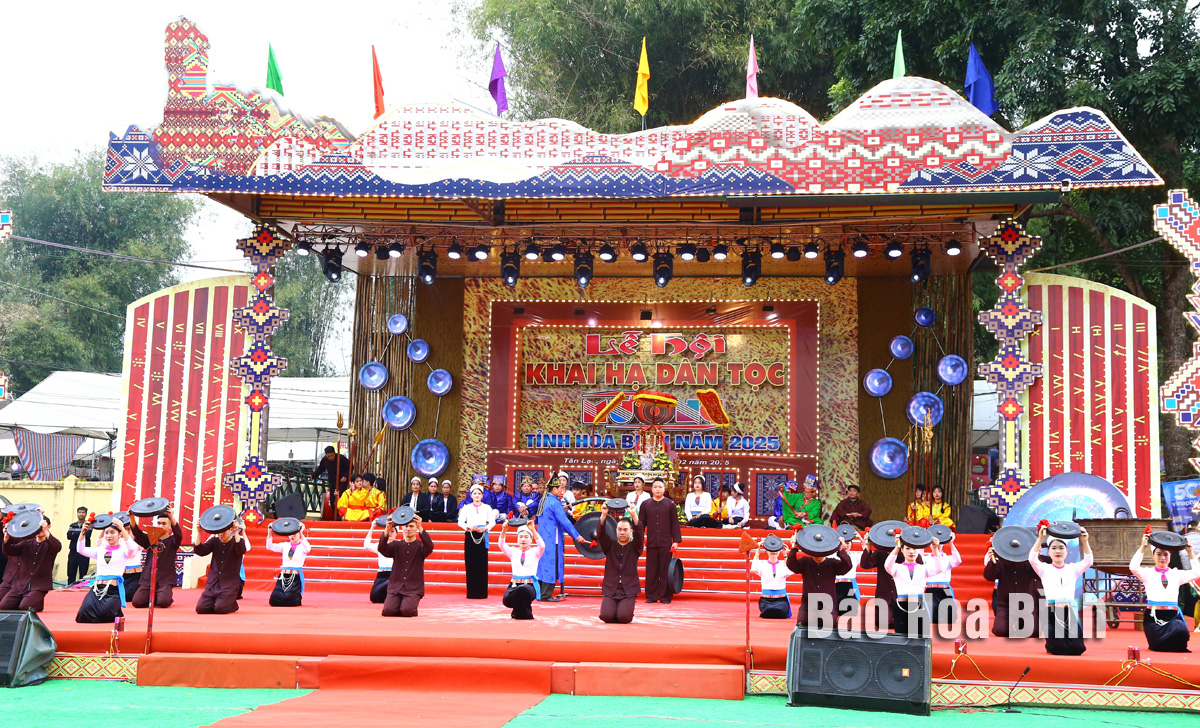
Hoa Binh province has harnessed its rich cultural heritage and human potential to forge the path towards sustainable development in the new era.
The
Khai ha (going down to the field) festival of the Muong ethnic group is held
annually to promote local cultural values.
The province is home to six main ethnic groups,
with the Muong people making up over 63% of the population. Each group
contributes distinctive cultural elements that create a diverse tapestry of
traditions. The locality boasts a long-standing historical and cultural values
with an array of festivals such as Tien Pagoda, Khai ha, Bo Temple, and Xen
Muong.
Besides, the province boasts the world-renowned
Hoa Binh Civilisation that dates back to prehistoric times, along with the four
major Muong regions of Bi, Vang, Thang, and Dong. Standing as a cradle of the
Vietnamese culture, Hoa Binh is now preserving hundreds of bronze drums and
nearly 10,000 precious gongs.
Seeing culture as a motivation for sustainable
development, the province has carried out various measures promote the values
of the Muong ethnic culture and the Hoa Binh Civilisation. It has emphasised
the people as both the centre and goal of development. Given this, the
provincial Party Committee has launched multiple action programmes to cultivate
locals’ ethics, lifestyle, and patriotism. The hardworking, compassionate, and
creative people of Hoa Binh have become the nucleus of all development policies
and also a bridge linking traditional values with the modern time.
According to Director of the provincial
Department of Culture, Sports and Tourism Quach Thi Kieu, Hoa Binh province has
paid due attention to preserving and promoting traditional cultural values. It
is home to 41 national heritage sites, 71 provincially ranked sites, and 303
protected historic and scenic locations. Additionally, 786 elements of
intangible cultural heritage from five ethnic minority groups – Muong, Thai,
Tay, Dao, and Mong – have been documented. One site has achieved special
national relic site status, while five intangible cultural elements have
received national recognition. In particular, a dossier has been compiled to
seek UNESCO's inclusion of the Mo Muong cultural heritage in the list of
heritage in need of urgent safeguarding.
Provincial authorities have implemented
strategic campaigns to attract socio-economic investment while preserving
cultural heritage through Resolution 04-NQ/TU, issued bythe provincial
Party Committee's Standing Board in October 2021, which outlines the
preservation and promotion of local ethnic groups' cultural heritage values for
2021–2025, with a vision to 2030.
The province has also activelypromoted
creativity among the public, resulting in numerous artistic works and cultural
programmes. Notably, it has worked to enhance cultural preservation in tandem
with tourism development. Tan Lac, Mai Chau, and Lac Son districts have become
popular destinations as they are able to capitalise on ethnic culture.
Hoa Binh is advancing by utilising its soft
power – cultural and human assets. Culture has become a strategic force driving
economic development, social stability, and improved living quality for local
residents.
Hoa Binh province is undergoing a dynamic transformation amid Vietnam’s national digital transition. Building on Poliburo’s Resolution No. 57-NQ/TW on breakthroughs in science, technology, innovation, and national digital transformation, the province has rolled out a wide range of practical action plans. A standout initiative is the "Digital Literacy for All” movement, an effort to ensure that no one is left behind in the digital era.
Hoa Binh province is undergoing a dynamic transformation in the wake of the national digital transformation movement. Building on Resolution No. 57-NQ/TW of the Politburo on breakthroughs in science, technology, innovation, and national digital transformation, the province has implemented a wide range of practical action plans. A standout initiative is the "Digital Literacy for All” movement ambitious effort to ensure that no one is left behind in the digital age.
With a spirit of unity and proactive problem-solving, the Party Committee, the government and the people of Dong Lai Commune (Tan Lac District) have made great strides in implementing the resolutions of the 24th Party Congress of the commune for the 2020 - 2025 term. Focusing on leadership and practical actions, the commune has brought the Party’s resolutions into daily life, creating strong impacts and pushing the local development forward.
Amid the nationwide push for digital transformation, young people in Hoa Binh Province are stepping up as dynamic pioneers, applying technology to enhance Youth Union operations and expand the reach of youth-led initiatives. Through creativity and adaptability, Youth Union organizations at all levels have introduced a series of practical solutions, contributing to modern governance and community development.
In recent years, An Nghia commune, located in Lac Son district, has stepped up administrative reform, focusing on improving the quality and efficiency of its single-window service unit for receiving and processing administrative procedures. These improvements have helped create favourable conditions for local residents and organisations to handle administrative procedures, contributing to the commune’s broader socio-economic development.
The Prime Minister-approved master plan to develop the multi-use value of forests ecosystems through 2030, with a vision to 2050, aims to improve the management and sustainable use of forest resources, create jobs, increase incomes, and improve the living standards of ethnic minorities, people in mountainous and remote areas, forest workers and those living near forests.



